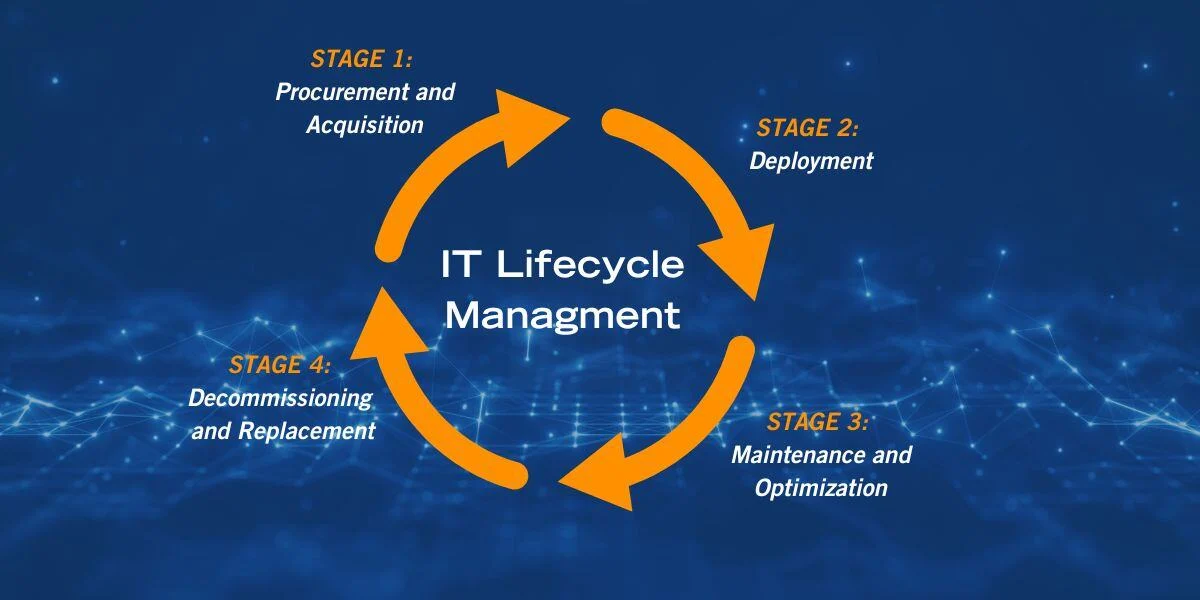Technology is the backbone of modern business operations. From communication systems and payment platforms to cloud storage and customer service tools, companies rely heavily on technology to remain competitive and efficient. However, technology is not static—it evolves rapidly, and hardware or software that was cutting-edge yesterday can quickly become outdated. This constant evolution presents businesses with both opportunities and challenges.
One of the most effective ways to maximize the value of technology while minimizing risks and costs is through Technology Lifecycle Management (TLM). This process involves planning, acquiring, deploying, maintaining, upgrading, and eventually retiring or replacing technology assets in a structured, strategic manner. By adopting a lifecycle approach, businesses not only ensure smooth operations but also achieve significant savings in time, money, and resources.
In this article, we’ll take a deep dive into the importance of technology lifecycle management, its stages, and how it saves organizations money while boosting efficiency.
What Is Technology Lifecycle Management?
Technology Lifecycle Management is the comprehensive process of overseeing an organization’s technology assets from the moment they are acquired until the point they are retired or recycled. Instead of treating technology purchases as one-time events, TLM views them as part of a continuous cycle that includes:
- Planning – Assessing organizational needs, setting budgets, and forecasting future requirements.
- Acquisition – Procuring hardware, software, and services based on strategic decisions.
- Deployment – Installing and integrating technology into workflows.
- Maintenance & Support – Monitoring performance, conducting updates, and ensuring systems remain functional.
- Upgrades & Scaling – Replacing or upgrading components to meet growing needs.
- Retirement & Disposal – Securely decommissioning, recycling, or reselling old technology.
Businesses that manage this cycle effectively gain a competitive advantage, while those that neglect it often face higher costs, inefficiencies, and security risks.
Why Technology Lifecycle Management Matters
Many organizations underestimate the long-term costs of technology. Purchasing hardware or software is only the beginning—ongoing maintenance, support, energy consumption, and eventual replacement all contribute to the total cost of ownership (TCO). Without structured lifecycle management, companies risk:
- Overspending on frequent replacements.
- Experiencing costly downtime due to equipment failures.
- Facing cybersecurity vulnerabilities from outdated devices.
- Wasting resources through poor recycling or disposal practices.
By contrast, businesses that adopt lifecycle management strategies can:
- Extend the useful life of technology assets.
- Reduce operational disruptions.
- Optimize return on investment (ROI).
- Enhance employee productivity and satisfaction.
The Key Stages of Technology Lifecycle Management
1. Planning
Every lifecycle begins with careful planning. Businesses must assess their current infrastructure and anticipate future needs. Questions to consider include:
- What are the company’s growth projections?
- Which departments require upgrades first?
- How long can existing assets remain functional?
- What budget is available for new technology?
A proactive planning phase reduces the risk of last-minute purchases, which are often more expensive and less effective.
2. Acquisition
After planning comes the acquisition of technology assets. Organizations must decide whether to buy new, lease, or consider refurbished equipment. Strategic acquisition saves money by avoiding unnecessary purchases and ensuring compatibility with existing systems.
Vendor selection also plays a role—long-term partnerships with reliable suppliers often result in better pricing, warranties, and support services.
3. Deployment
Deployment involves setting up the technology, integrating it into workflows, and training employees. A smooth deployment minimizes downtime and accelerates adoption. Businesses that invest in structured onboarding and staff training typically see higher productivity and fewer technical issues.
4. Maintenance & Support
Technology requires continuous monitoring and maintenance to function at peak performance. Regular updates, patch management, and performance checks prevent disruptions and extend equipment lifespan. Neglecting maintenance often leads to costly breakdowns or vulnerabilities.
Support services—whether in-house IT or outsourced providers—are also critical. Quick response to technical issues reduces downtime and keeps operations running smoothly.
5. Upgrades & Scaling
As a business grows, so does its demand for more advanced technology. Upgrades ensure that systems remain relevant and capable of supporting new workflows. Scaling might involve adding servers, expanding storage, or integrating advanced analytics.
By planning upgrades strategically, businesses can spread costs over time rather than facing large, unexpected expenses.
6. Retirement & Disposal
Every piece of technology eventually reaches the end of its lifecycle. At this stage, businesses must securely retire equipment. Data destruction is critical to prevent security breaches, while recycling or reselling equipment promotes sustainability and can even generate additional revenue.
Companies that skip structured retirement processes often face compliance risks, environmental issues, or lost opportunities for cost recovery.
How Technology Lifecycle Management Saves Time
Reduced Downtime
“Well-managed technology is less likely to break down unexpectedly. Routine maintenance, proactive upgrades, and structured retirement prevent the operational downtime that can disrupt workflows and frustrate customers.” adds Jim Remke, Director of Business Development at POSRG
Streamlined Processes
A structured lifecycle means IT teams are not constantly reacting to emergencies. Instead, they follow predictable schedules for updates, deployments, and retirements. This efficiency saves hours of troubleshooting and crisis management.
Faster Employee Onboarding
With standardized devices and software, new employees can be onboarded quickly. Familiarity and consistency reduce the time spent training staff on different systems.
How Technology Lifecycle Management Saves Money
Lower Total Cost of Ownership (TCO)
“By planning ahead and maintaining assets properly, businesses extend the lifespan of their technology. This reduces the frequency of expensive replacements and ensures that each asset provides maximum value.” adds Tigran Sloyan, Chief Executive Officer of CodeSignal
Optimized Procurement
Strategic acquisition allows businesses to negotiate better deals with vendors and avoid unnecessary purchases. Bulk buying, leasing, or choosing refurbished equipment can result in substantial savings.
Energy Efficiency
Upgrading outdated systems to more energy-efficient models reduces utility bills. Over time, these savings can be significant—especially for businesses running multiple devices across large networks.
Improved Security and Compliance
Data breaches and compliance violations are costly. Lifecycle management ensures timely updates, secure data disposal, and reduced risk of unauthorized access—all of which save money by avoiding penalties, lawsuits, and reputational damage.
Recycling & Resale Value
Retired technology doesn’t always have to go to waste. Many businesses recover costs through resale programs or by recycling parts, reducing the financial burden of constant upgrades.
Case Study Example (Hypothetical)
Imagine a mid-sized retail chain with 50 stores. Without lifecycle management, the company experiences frequent POS terminal breakdowns, causing checkout delays and frustrating customers. Each emergency repair costs hundreds of dollars, and replacing equipment piecemeal is expensive and inefficient.
By implementing a structured lifecycle management plan, the chain:
- Schedules regular maintenance and updates.
- Acquires refurbished POS hardware to cut costs.
- Plans upgrades across all stores simultaneously for efficiency.
- Securely recycles old hardware, reducing environmental impact.
Within three years, the company saves over $250,000 in reduced downtime, optimized purchasing, and extended asset lifespans—while also improving customer satisfaction.
Best Practices for Effective Lifecycle Management
- Create a Clear Inventory – Track all technology assets with details like purchase date, warranty, expected lifespan, and current status.
- Standardize Where Possible – Using consistent devices and software simplifies maintenance and training.
- Schedule Regular Reviews – Assess hardware and software performance annually to plan timely upgrades.
- Work With Trusted Vendors – Strong partnerships often provide better support and cost savings.
- Prioritize Security – Ensure timely updates, patch management, and certified data destruction for retired devices.
- Emphasize Sustainability – Choose energy-efficient equipment and recycle responsibly.
The Future of Technology Lifecycle Management
As businesses increasingly adopt cloud solutions, AI, and IoT devices, the complexity of technology management will grow. Lifecycle management will become even more critical in reducing costs, minimizing risks, and ensuring smooth digital transformation.
Emerging trends include:
- Automation in Lifecycle Tracking – Using AI to monitor device health and predict failures before they occur.
- Sustainability Integration – Stronger emphasis on environmentally friendly retirement and recycling practices.
- As-a-Service Models – Leasing or subscription-based technology models that build lifecycle management into the service.
Conclusion
Technology is not just a tool—it is an investment that requires careful stewardship. Businesses that adopt Technology Lifecycle Management (TLM) save both time and money while ensuring security, compliance, and efficiency.
From planning and acquisition to retirement and recycling, every stage of the lifecycle offers opportunities for cost savings and productivity gains. In an age where technology drives competitiveness, businesses that manage their tech assets strategically will be best positioned for long-term success.



































